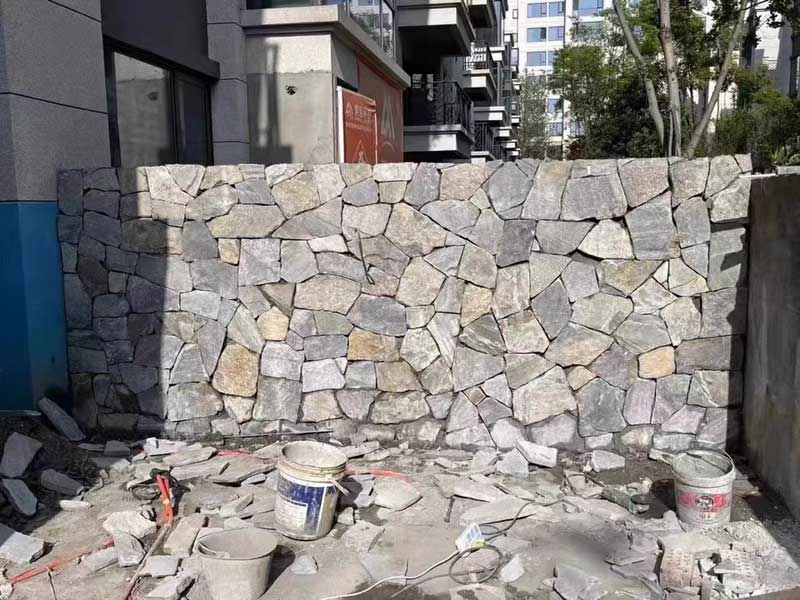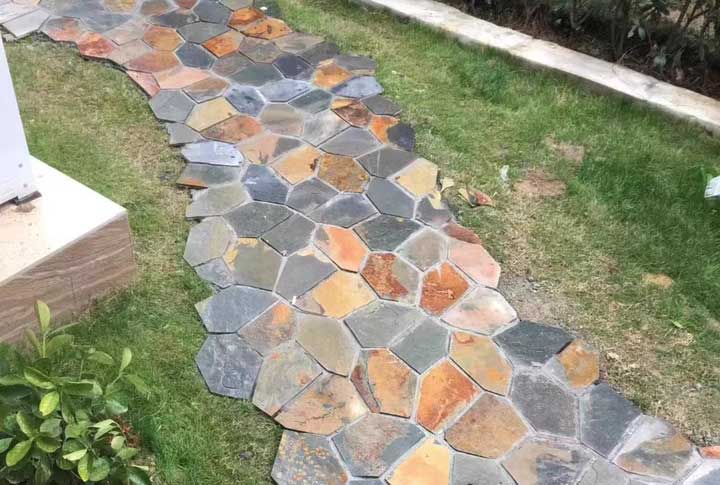Crazy paving is a unique and durable option for outdoor spaces, offering a natural, rustic look that blends seamlessly with various landscapes. However, laying crazy paving requires careful planning and execution to ensure a long-lasting and aesthetically pleasing result. In this guide, I’ll walk you through the process of laying crazy paving, from pre-installation considerations to post-installation care.
Crazy paving is a unique and durable option for outdoor spaces. To lay crazy paving, start by preparing a solid substrate, mix mortar or adhesive, and lay the stones with consistent spacing. Finish with grouting and sealing for long-lasting results. Always follow manufacturer guidelines and consult professionals for best practices.
1. What is Crazy Paving?
Crazy paving is a timeless and versatile paving style that uses irregularly shaped stones to create unique patterns. It is celebrated for its natural, artistic look and ability to enhance the aesthetic appeal of outdoor spaces, pathways, and even indoor areas. Each piece of crazy paving is distinct, reflecting the natural variations in stone, which adds character and individuality to the final layout.
Why Choose Crazy Paving for Your Project?
Crazy paving stands out for its durability, natural beauty, and adaptability to different environments. It is an excellent choice for homeowners and designers seeking a unique look for driveways, patios, garden paths, and even feature walls. Its versatility allows it to complement modern, rustic, or traditional design themes while offering practical benefits like longevity and slip resistance.
2. Preparation Before Installation
Q1: What materials and tools do you need?
Materials:
- Crazy Paving Stones: Available in various natural stones like slate, quartzite, or sandstone. Choose stones that suit your design and environment.
- Mortar or Adhesive: Use a high-quality product suited to your chosen installation method.
- Bonding Slurry: Enhances adhesion between the substrate and the stones.
- Pre- and Post-Installation Sealers: Protects the stone and enhances its durability.
- Grout: Ensure compatibility with the paving material and weather conditions.
Tools:
- Rubber Mallet: For tapping stones into place without damaging them.
- Wet Saw or Diamond Blade Cutter: For precise cutting of stones.
- Notched Trowel (8-12mm): Ensures even application of mortar or adhesive.
- Spirit Level: Maintains evenness and proper slope.
- Safety Gear: Includes a dust mask, gloves, and goggles to ensure protection during cutting and handling.
Q2: How should you prepare the site?
Substrate and Base:
- Ensure the substrate is stable, clean, and free of debris. For pedestrian areas, use a reinforced concrete base with a minimum thickness of 75mm. For vehicle traffic, the base should be at least 100mm thick with reinforcement.
Drainage and Slopes:
- Proper drainage is essential to prevent water pooling and surface damage. Maintain a slope of at least 1% for small areas and 2% for larger surfaces.
- Incorporate drainage channels or outlets as needed.
Control Joints:
- Use control joints to minimize cracking caused by temperature changes and substrate movement. Include expansion joints every 20m² and ensure they extend through the substrate, mortar bed, and paving layer.
3. Installation Methods
Crazy paving can be installed using two primary methods: the Wet Bed Installation Method and the Adhesive Installation Method. The choice of method depends on the thickness variation of the stones and the specific requirements of your project.
Wet Bed Installation Method
This method is ideal for stones with significant thickness variation (greater than 6mm). It involves using a mortar bed to accommodate the unevenness of the stones.
Prepare the Substrate:
- Clean the Surface: Ensure the concrete slab is clean, level, and free of debris. Remove any dust, dirt, oil, or grease that could affect adhesion.
- Dampen the Substrate: Lightly dampen the substrate with water to improve the bond between the mortar and the concrete. Avoid over-saturating the surface.
Mix the Mortar:
- Ingredients: Combine 3 parts coarse washed sand, 1 part Portland cement, and 1 part clean water. The sand should be washed and free of impurities to ensure a strong mix.
- Mixing: Use a paddle mixer or a barrel cement mixer to blend the ingredients thoroughly. Mix until the mortar is lump-free and has a workable consistency. You can add more water if needed, but avoid making the mix too wet.
- Optional Additives: To improve the strength and workability of the mortar, you can add a bonding agent like Laticrete Everbond or Mapei Planicrete SP. Follow the manufacturer’s instructions for mixing ratios.
Apply Bonding Slurry:
- Prepare the Slurry: Mix cement with water or a bonding agent to create a thin, paste-like slurry.
- Application: Spread a thin layer (1-2mm) of the bonding slurry on the substrate where the mortar will be applied. This helps to create a strong bond between the mortar and the concrete.
Lay the Mortar Bed:
- Spread the Mortar: Apply the mortar mix evenly over the substrate to a thickness of 25mm. Use a trowel to spread the mortar, ensuring there are no voids or air pockets.
- Level the Bed: Use a straightedge or leveling tool to ensure the mortar bed is even and flat. This is crucial for achieving a level surface when laying the stones.
Lay the Stones:
- Prepare the Stones: Clean the back of each stone to remove any loose material or dust. Apply a thin layer of bonding slurry to the back of the stone to improve adhesion.
- Place the Stones: Position the stones onto the mortar bed, starting from one corner and working your way out. Gently tap each stone into place using a rubber mallet. Ensure there are no air voids beneath the stones.
- Maintain Joint Spacing: Use spacers to maintain consistent joint spacing (7-10mm). This spacing allows for grout to be applied later and helps to accommodate any movement in the stones.
Fill Joints and Clean Up:
- Fill Gaps: Fill any gaps around the stones with mortar and remove excess mortar with a trowel.
- Clean the Surface: Use a damp sponge to clean the surface of the stones, removing any mortar residue. Work carefully to avoid staining the stones.
Adhesive Installation Method
This method is suitable for stones with minimal thickness variation (less than 6mm). It involves using a synthetic adhesive to fix the stones directly to the substrate.
Prepare the Substrate:
- Clean the Surface: Ensure the substrate is clean, level, and free of debris. Remove any dust, dirt, oil, or grease that could affect adhesion.
- Allow to Cure: If the substrate is a screed bed or concrete, allow it to cure according to the manufacturer’s specifications before applying the adhesive.
Mix the Adhesive:
- Follow Manufacturer’s Instructions: Use a high-quality synthetic adhesive like Ardex X18 or Mapei Keraquick Maxi S1. Follow the manufacturer’s instructions for mixing the adhesive. Typically, you’ll mix the adhesive powder with water or an additive to achieve a smooth, creamy consistency.
- Mixing: Use a low-speed mixer to blend the adhesive until it is lump-free and has a uniform consistency. Allow the adhesive to slake (rest) for a few minutes, then mix again before use.
Apply the Adhesive:
- Spread the Adhesive: Use a notch trowel (8-10mm) to spread the adhesive evenly on the substrate. The notches help to create an even layer of adhesive that will bond well with the stones.
- Back-Butter the Stones: Apply a thin layer of adhesive to the back of each stone before placing it on the substrate. This ensures full coverage and a strong bond.
Lay the Stones:
- Place the Stones: Position the stones onto the adhesive bed, starting from one corner and working your way out. Gently tap each stone into place using a rubber mallet. Ensure there are no air voids beneath the stones.
- Maintain Joint Spacing: Use spacers to maintain consistent joint spacing (7-10mm). This spacing allows for grout to be applied later and helps to accommodate any movement in the stones.
Clean Up:
- Remove Excess Adhesive: Use a damp sponge to remove any excess adhesive from the surface of the stones before it sets. Work carefully to avoid staining the stones.

4. Step-by-Step Installation Guide
Preparing the Substrate
- Clean the Surface: Remove all dust, dirt, oil, and debris from the substrate. A clean surface is essential for proper adhesion.
- Check for Levelness: Use a spirit level to ensure the substrate is level and free of any uneven spots. If necessary, use a leveling compound to correct any unevenness.
- Dampen the Substrate: Lightly dampen the substrate with water to improve adhesion. Avoid over-saturating the surface, as this can weaken the bond.
Mixing Mortar or Adhesive
- For Wet Bed Installation: Mix 3 parts coarse washed sand, 1 part Portland cement, and 1 part clean water. Add more water if needed to achieve the desired consistency. Optionally, add a bonding agent to improve strength and workability.
- For Adhesive Installation: Follow the manufacturer’s instructions for mixing the adhesive. Typically, you’ll mix the adhesive powder with water or an additive to achieve a smooth, creamy consistency.
Laying the Crazy Paving
- Apply Bonding Slurry: Spread a thin layer of bonding slurry on the substrate to improve adhesion.
- Lay the Stones: Place the stones onto the mortar or adhesive bed, tapping them gently with a rubber mallet to ensure proper adhesion. Use spacers to maintain consistent joint spacing (7-10mm).
- Cutting and Adjusting Stones: Use a wet diamond blade to cut stones to size. Clean the stones immediately after cutting to remove any residue.
Grouting and Sealing
- Fill Joints with Grout: Use a rubber grout float to fill the joints with grout, ensuring there are no voids. Remove excess grout from the surface of the stones with a damp sponge.
- Apply Sealer: Once the grout has cured, apply a sealer to protect the stones and enhance their appearance. Follow the manufacturer’s instructions for applying the sealer.
Top 10 Crazy Paving Flagstone Wholesalers in Australia
Top 10 Stacked Stone Cladding Wholesalers in Australia.
5. Post-Installation Care
Cleaning and Maintenance
- Regular Cleaning: Sweep the surface regularly to remove dirt and debris. Use a pH-neutral cleaner to clean the stones without damaging them. Avoid using acidic cleaners, as they can damage the stone and the sealer.
- Remove Stains Promptly: Address any spills or stains immediately to prevent them from setting into the stone. Use a stone-safe cleaner like ProNeutro for effective stain removal.
Re-Sealing Recommendations
- Frequency: Re-seal your crazy paving every 5-7 years, especially in high-traffic areas or harsh environments. Regular sealing helps to maintain the stone’s appearance and protect it from moisture and stains.
- Choosing a Sealer: Use a high-quality sealer like Solv Sealer Gold or Defender CSD 50 for optimal protection. These sealers provide a natural look while offering strong moisture repellency.
- Application: Follow the manufacturer’s instructions for applying the sealer. Ensure the surface is clean and dry before sealing. Apply the sealer evenly and allow it to cure fully before exposing the surface to traffic.
Long-Term Maintenance
- Inspect for Damage: Regularly inspect the paving for any cracks, chips, or loose stones. Address any issues promptly to prevent further damage. If necessary, re-grout the joints to maintain the integrity of the installation.
- Protect from Heavy Loads: Avoid placing heavy loads on the paving, especially in areas with vehicular traffic, to prevent cracking or shifting. Use protective mats or pads under heavy objects to distribute the weight evenly.
By following these detailed steps for installation and post-installation care, you can ensure that your crazy paving remains beautiful and functional for years to come. Proper preparation, careful installation, and regular maintenance are key to achieving a long-lasting and visually appealing result.
6. Common Mistakes and How to Avoid Them
Poor Substrate Preparation:
- Skipping proper site preparation can lead to uneven surfaces and weak adhesion. Always ensure the substrate is stable, clean, and appropriately reinforced.
Insufficient Drainage:
- Neglecting drainage planning can result in water pooling, efflorescence, and long-term damage. Ensure slopes and drainage points are properly designed.
Inconsistent Appearance:
- Failing to mix stones from multiple crates can cause noticeable color and texture variations. Mix stones randomly for a cohesive look.
Incorrect Adhesive or Mortar Use:
- Using the wrong adhesive or mortar mix can weaken the bond. Follow manufacturer guidelines for mixing and application.
Skipping Sealing Steps:
- Not sealing the stones increases their susceptibility to stains and weathering. Always pre- and post-seal for maximum durability.
Overlooking Safety:
- Inadequate safety precautions during cutting and installation can lead to injuries. Always wear protective gear and work in a well-ventilated area.
10. Call to Action
Are you ready to transform your space with the timeless beauty of Crazy paving? At Top Source Stone, we provide premium-quality natural stones and expert advice to help you achieve stunning results. From selection to installation, we’re here to guide you every step of the way.
Visit our website to explore our range of crazy paving stones and accessories. Contact us today for person

